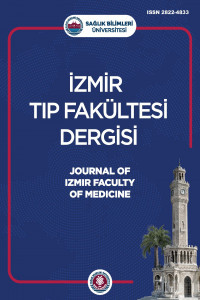Koroner Baypas Cerrahisinde İleri Yaş Grubunda Sol İnternal Torasik Arter Kullanımı
Koroner bay pas, ileri yaş, greft, greft
Use of left internal thoracic artery in the advanced age group in coronary bypass surgery
coronary bypass surgery, greft, advanced age,
___
- Referans1. Lytle BW, Loop FD, Cosgrove FD, Ratliff NB, Easley K, Taylor PC. Long-term (5–12 years) serial studies of internal thoracıc artery and saphenous vein coronary bypass grafts. J Thorac Cardiovasc Surg. 1985;89:248-58.
- Referans2. Loop FD, Lytle BW, Cosgrove DM, Stewart RW, Goormastic M, Williams GW et al. Influence of internal thoracıc artery graft on 10-year survival and other cardiac events. N Engl J Me.d 1986;314:1-6.
- Referans3. Cameron AA, Green GE, Brogno DA, Thornton J. Internal thoracic artery grafts: 20-year clinical follow-up. J Am Coll Cardiol. 1995;25:188-92.
- Referans4. Barner HB, Swartz MT, Mudd JG, Tyras DH. Late patency of the internal thoracıc artery as a coronary bypass conduit. Ann Thorac Surg. 1982;34:408-12.
- Referans5. Cameron A, Kemp HG Jr, Green GE. Bypass surgery with the internal thoracıc artery graft: 15 year follow-up. Circulation. 1986;74:30-6.
- Referans6. Barner HB, Standeven JW, Reese J. Twelve-year experience with internal thoracıc artery for coronary artery bypass. J Thorac Cardiovasc Surg. 1985;90:668-75.
- Referans7. Cameron A, Davis KB, Green G, Schaff HV. Coronary bypass surgery with internal-thoracic-artery grafts - effects on survival over a 15-year period. N Engl J Med. 1996;334:216-19.
- Referans8. Morris RJ, Strong MD, Grunewald KE, Kuretu ML, Samuels ML, Kresh JY et al. Internal thoracic artery for coronary artery grafting in octogenarians. Ann Thorac Surg. 1996;62:16-22.
- Referans9.Rihal CS, Raco DL, Gersh BJ, Yusuf S: Indications for coronary artery bypass surgery and percutaneous coronary intervention in chronic stable angina: review of the evidence and methodological considerations. Circulation. 2003;108:2439-45.
- Referans10. Hillis LD, Smith PK, Anderson JL, Bittl JA, Bridges CR, Byrne JG et al. ACCF/AHA guideline for coronary artery bypass graft surgery: executive summary: a report of the American college of cardiology foundation/American heart association task force on practice guidelines. Circulation. 2011;124: 2610-42.
- Referans11. Yusuf S, Zucker D, Passamani E, Peduzzi P, Takaro T, Fisher LD et al. Effect of coronary artery bypass graft surgery on survival: overview of 10-year results from randomised trials by the coronary artery bypass graft surgery trialists collaboration. Lancet. 1994;344:563–570.
- Referans12. Favarato ME, Hueb W, Boden WE, Lopes N, Nogueira CR, Takiuti M et al. Quality of life in patients with symptomatic multivessel coronary artery disease: a comparative post hoc analyses of medical, angioplasty or surgical strategies-MASS II trial. Int J Cardiol 2007; 116:364-70.
- Referans13. Kappetein AP, Feldman TE, Mack MJ, Morice MC, Holmes DR, Stahle E et al. Comparison of coronary bypass surgery with drug-eluting stenting for the treatment of left main and/or three-vessel disease: 3-year follow-up of the SYNTAX trial. Eur Heart J, 2011;32: 2125-34.
- Referans14. Drouin A, Noiseux N, Chartrand-Lefebvre C, Soulez G, Mansour S, Tremblay JA et al. Composite versus conventional coronary artery bypass grafting strategy for the anterolateral territory: study protocol for a randomized controlled trial. Trials. 2013;14:270.
- Referans15.Moller CH, Perko MJ, Lund JT, Andersen LW, Kelbaek H, Madsen JK et al. Graft patency after off-pump versus on-pump coronary artery surgery in high-risk patients. Scand Cardiovasc J. 2010;44: 161-67.
- Referans16.Bridgewater B, Grayson AD, Au J, Hassan R, Dihmis WC, Munsch C et al. Improving mortality of coronary surgery over first four years of independent practice: retrospective examination of prospectively collected data from 15 surgeons. BMJ. 2004;329:421.
- Referans17. Muneretto C, Negri A, Manfredi J, Terrini A, Rodella G, Elgarra S et al. Safety and usefulness of composite grafts for total arterial myocardial revascularization (a prospective and randomised evaluation). J Thorac Cardiovasc Surg. 2003;125:826-35.
- Referans18. S Karthık, B. Fabrı. Left internal thoracıc artery usage in coronary artery bypass grafting: a qualıty control marker. Ann R Coll Surg Engl. 2006;88:367-69.
- Başlangıç: 2022
- Yayıncı: Sağlık Bilimleri Üniversitesi
COVID - 19 Adolesanları Nasıl Etkiledi?
Zeynep Özün ERİNÇ, Kayı ELİAÇIK
Varisella Zoster Virus İlişkili Myeloradikulonöropati: Olgu Sunumu
İrem Fatma AŞAN, Şule BİLGİN, Hande TURAN, Ufuk ŞENER
Pediatrik Parmak Replantasyonları: 31 Olgunun Retrospektif Değerlendirilmesi
Soysal BAŞ, Sabri ÖZTÜRK, Furkan ÇEŞTEPE, Ömer Faruk DİLEK, Kamuran Zeynep SEVİM
Warthin Tümöründe Müsinöz Metaplazi Değerlendirilmesi
Ceren ENÇ, Esra Canan KELTEN TALU, Ülkü KÜÇÜK
Nadir Pediatrik Olgu: Nazal Miyazis
Esin KASAP, Fatmahorasan ALTINTAŞOĞLU
Nisa YILDIZ, Celal Buğra SEZEN, Gamze TANRIKULU, Muzaffer METİN
The Second to Fourth Digit Ratio in Patients with Hidradenitis Suppurativa
Melis GÖNÜLAL, Didem ALTINER, Aylin ÖZTÜRK, Kenan TEKER, Sinan DOĞAN, Meltem TURKMEN
Koroner Baypas Cerrahisinde İleri Yaş Grubunda Sol İnternal Torasik Arter Kullanımı
